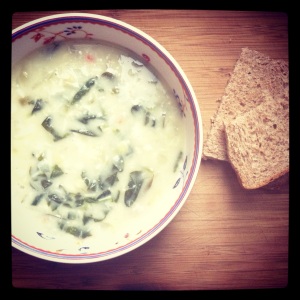coconut milk
Is-really-a-stew! (Ishtu Keralan stew/soup)
I was in Kerala in October 2012 and it was a delight in more ways than I could ever begin to describe.
One of the reasons is of course that Keralan cuisine is at the top end of the eating experiences that India could offer you. Kerala is in some ways gourmet India, a land blessed with tropical fruits, vegetable and spices and the starting points of many trails of wealth and cultural influence. If you are a culture vulture, a foodie, and a seeker of genuine community spirit, serenity and natural diversity you should make some time to visit Keralan land.
The stew dish I am introducing today is not one I tried when in Kerala- when by the way I was delighted to wake up to savoury rice puddings with egg curry for breakfast.
I learned how to cook Istoo on my return to Wales and whilst reading Vijayan Kannampilly’s, Keralan Cookbook. It is very easy to make, it is light and nutritious, and below is my fish version of it, which I hope you enjoy.
Istoo ingredients for six
700gr white fish (skinless and bones) [1]
3-4 medium potatoes , cubed (3cm cubes)
100-150g finely chopped ginger
1-2 coarsely chopped medium onions
1 finely chopped chili pepper
1 stalk of fresh curry leaves or a handful of dried curry leaves
2-3 tbsp coconut oil or vegetable oil
250-200g spinach
2-3 tins of coconut milk
Salt and pepper (about 1 tsp each)
Preparation
Place the potatoes, ginger, onions, chili in a deep pot and add enough boiling water to cover the ingredients.
Season and simmer until the potatoes are just soft.
Add the fish cubed in big chunks, and if the fish is not covered add some more boiling water.
Simmer for another 5 minutes or until the fish is cooked.
Stir in the coconut milk, add the coconut leaves and heat to a low simmer [2].
Option: add the washed spinach leaves to the stew as you do this.
Once the stew has reached its simmer turn the heat off.
Heat the coconut separately or other oil and pour it in.
Taste and season more if necessary before serving .
Notes
[1] You can find out about what fish you should consume to minimise your impact on our sees at the Marine Conservation Society’s website: http://www.goodfishguide.co.uk/. Look for alternatives to monkfish for this stew.
[2] You can add two of the coconut milk tins and some water for a thicker stew that is not as strong in coconut flavor. Or for a more soup-like version of the stew add some three tins of coconut milk and some more water.


Petra and a Chickpea and Kale curry recipe
Posted on Updated on
How did Petra and her recipe enter my life? How do you summarise a friendship?
This slideshow requires JavaScript.
I will never forget the first time I saw Petra’s smiley face in the corridors of City and Regional Planning, Cardiff University, when she came over to Wales as a visiting researcher. I remember long nights with emotional conversations and loud laughter. I remember dancing at the Toucan on St Mary Street and Journeys on Clifton Street.
In August 2011, I found Petra again. Crete returned to me a friend, as well as serenity and a sense of home. But then again that is also what a good friend gives. I hugged Petra tightly after 5 years during which our individual journeys were coinciding and sometimes merging in the ether, without us knowing: searching, coping, understanding and finding.
In Crete, the land that generously offers good food and sun, we met and talked about food, love, life and dreams again. It’s good to be reminded of all that bonds you deeply with another person.
My friend Petra loves food, cooking and life. She is also a rural sociologist who is passionate about sustainable food and approaches the subject from a cultural angle: understanding cultures and consumerist patterns, and changing attitudes. She teaches and researches at the University of Wageningen, the Netherlands and build a ‘Food Cultures and customs’ course in 2010. And last year Petra was also a part-time organic farmer for the growing season. What a woman!
Petra writes for a couple of blogs: the rural sociology group blog, university of Wageningen and Pure Food links, a sustainable food network blog. Recently, she visited Brasil and, in a couple of entries at the end of October and November 2011, she tell us about national school food programmes, and particularly Dos Irmáos School ,the Rio Grande do Sul, which she visited. Legislation requires that 30% of fresh produce used in school food comes from local farms: shortening the supply chain with various possible good impacts for the environment, economy, etc. springing to my mind at first glimpse.
Apart from the curry she recommended this month, when I think of Petra and food two dishes spring to mind: garlic and chilli prawns served with fresh bread, and roast lamb. I remember a roast lamb dinner when suddenly it dawned on us that everyone around the dining table was a Libra, with the exception of me who was born on the cusp: what a strange coincidence that so many of us hanging out regularly, making lasting friendships, were born within a month of each other either in the same year or a couple of years apart either way.
I adapted Sarah Raven’s chickpea curry recipe recommended by Petra and whilst cooking her felt presence in Cardiff once again.
Ingredients
Preparation:
Tip: I froze a couple of portions of the curry and save for yummy lunches this week. This dish was as delicious when defrosted and consumed two weeks after I cooked it.
Share this:
This entry was posted in Comment, Recipes and tagged Brasil school food programme, Cardiff, Cardiff University, chickpea and kale curry, chikpeas, coconut milk, coriander, curly kale recipes, curry powder. spice of life, food, food blog, food photography, ginger, kale, lime, mushroom recipes, Petra Derkzen, Prof Terry Marsden, recipes, Roath park, rural sociology, Sarah Raven recipe, shrimp paste, Splott, Tom Woollam, university of wageningen, vegetarian.